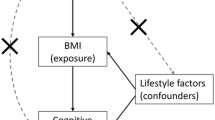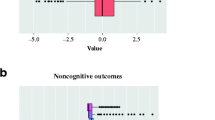Abstract
We use data on 11–15-year-old boys in the West Bank to study the empirical link between cognitive ability and health behavior, specifically (teen) smoking. Adjusting for both age in months and grade level allows us to effectively shut down any simultaneous effect of maturation and schooling on cognitive ability and smoking. We find that those at the lower end of the cognitive ability distribution are more than twice as likely to smoke than those at the upper end (approximately 25 versus 10%) also after adjusting for parental background and peer composition in a generalized propensity score approach. Further, we find that the cognitive ability-smoking gradient is fairly flat at the lower end of the cognitive ability distribution and steep at the upper end.



Similar content being viewed by others
Notes
See https://staging.tobaccocontrollaws.org/legislation/country/palestine/summary (accessed 2019-09-03) for English translations.
http://www.maannews.net/Content.aspx?id=989109 (accessed 2019-09-03).
We chose the number of knots by visual inspection of the estimated relationship. With larger numbers of knots, we found implausibly increasing segments in the dose–response function, which we considered to be the result of over-fitting However, in principle, one could also choose the number of knots by cross-validation.
References
Abdulrahim, S., Jawad, M.: Socioeconomic differences in smoking in Jordan, Lebanon, Syria, and Palestine: a cross-sectional analysis of national surveys. PLoS One 13(1), 1–11 (2018)
Anstey, K.J., Low, L.-F., Christensen, H., Sachdev, P.: Level of cognitive performance as a correlate and predictor of health behaviors that protect against cognitive decline in late life: the path through life study. Intelligence 37(6), 600–606 (2009)
Auld, C.M., Sidhu, N.: Schooling, cognitive ability and health. Health Econ. 14(10), 1019–1034 (2005)
Austin, P.C.: Assessing the performance of the generalized propensity score for estimating the effect of quantitative or continuous exposures on binary outcomes. Stat. Med. 37(11), 1874–1894 (2018)
Bijwaard, G., van Kippersluis, H.: Efficiency of health investment: education or intelligence? Health Econ. 25(9), 1056–1072 (2016)
Cahan, S., Cohen, N.: Age versus schooling effects on intelligence development. Child Dev. 60(5), 1239–1249 (1989)
Card, D.: Chapter 30 - the causal effect of education on earnings, Part A of Handbook of Labor Economics, vol. 3, pp. 1801–1863. Elsevier, Amsterdam (1999)
Clark, D., Royer, H.: The effect of education on adult mortality and health: evidence from britain. Am. Econ. Rev. 103(6), 2087–2120 (2013)
Cunha, F., Heckman, J.: The technology of skill formation. Am. Econ. Rev. 97(2), 31–47 (2007)
Cutler, D.M., Lleras-Muney, A.: Understanding differences in health behaviors by education. J. Health Econ. 29(1), 1–28 (2010)
de Walque, D.: Does education affect smoking behaviors? Evidence using the Vietnam draft as an instrument for college education. J. Health Econ. 26(5), 877–895 (2007)
Farrell, P., Fuchs, V.R.: Schooling and health. J. Health Econ. 1(3), 217–230 (1982)
Gottfredson, L.S.: Intelligence: Is it the epidemiologists’ elusive” fundamental cause” of social class inequalities in health? J. Pers. Soc. Psychol. 86(1), 174–199 (2004)
Grossman, M.: The relationship between health and schooling: what’s new? Nordic J. Health Econ. 3(1), 7–17 (2015)
Hansen, K.T., Heckman, J.J., Mullen, K.J.: The effect of schooling and ability on achievement test scores. J. Econ. 121(1), 39–98 (2004)
Harrell, F.E.: RMS: Regression Modeling Strategies. R package version 5.1-2 (2018). https://CRAN.R-project.org/package=rms
Hirano, K., Imbens, G.W.: The propensity score with continuous treatments. In: Gelman, A., Meng, X.-L. (eds.) Applied Bayesian Modeling Causal Inference from Incomplete-Data Perspectives, pp. 73–84. Wiley, New York (2004)
Imai, K., van Dyk, D.A.: Causal inference with general treatment regimes. J. Am. Stat. Assoc. 99(467), 854–866 (2004)
Jensen, R., Lleras-Muney, A.: Does staying in school (and not working) prevent teen smoking and drinking? J. Health Econ. 31(4), 644–657 (2012)
Jürges, H., Meyer, S.-C.: Educational differences in smoking: selection versus causation. J. Econ. Stat. (2019). https://doi.org/10.1515/jbnst-2019-0004
Jürges, H., Reinhold, S., Salm, M.: Does schooling affect health behavior? Evidence from the educational expansion in Western Germany. Econ. Educ. Rev. 30(5), 862–872 (2011)
Manski, C.F.: Identification of endogenous social effects: the reflection problem. Rev. Econ. Stud. 60(3), 531–542 (1993)
Maralani, V.: Understanding the links between education and smoking. Soc. Sci. Res. 48, 20–34 (2014)
Mocan, N., Altindag, D.T.: Education, cognition, health knowledge, and health behavior. Eur. J. Health Econ. 15(3), 265–279 (2014)
Wennerstad, K.M., Silventoinen, K., Tynelius, P., Bergman, L., Kaprio, J., Rasmussen, F.: Associations between IQ and cigarette smoking among Swedish male twins. Soc. Sci. Med. 70(4), 575–581 (2010)
Author information
Authors and Affiliations
Corresponding author
Additional information
The analysis presented in this paper is part of the project “Determinants of Cognitive Development in Deprived Environments: Evidence from the West Bank” funded by the German Research Foundation (DFG) under Grant number JU 2769/2. We are grateful to the Palestinian Ministry of Education and Higher Education, test administrators, and the students who participated in our study for their time and effort. We also thank two anonymous reviewers for their helpful comments.
Appendices
Appendix 1: Balancing test for schools
See Fig. 4.
Appendix 2: Construction of indices
Living standards index
The living standards index is constructed as the sum of affirmative answers to the following question: “Does your household have ...(code all that apply):
- 1.
Television.
- 2.
Telephone (mobile or landline).
- 3.
Refrigerator.
- 4.
Dishwasher.
- 5.
Computer.
- 6.
DVD player.
- 7.
Central heating.
- 8.
Air condition.
- 9.
Private car, van, or truck.
Joint family activity index
The joint family activity index is constructed as the mean of the answers to the following question: “Below is a list of some things that families do together. How often do you and your family do these things together?” (Answer categories: every day = 5, most days = 4, about once a week = 3, less than once a week = 2, never = 1).
- 1.
Watch TV or video together.
- 2.
Play indoor games together.
- 3.
Eat meals together.
- 4.
Go for a walk together.
- 5.
Go places together.
- 6.
Visit friends or relatives together.
- 7.
Play sports together.
- 8.
Sit and talk about things together.
General health index
The general health index is constructed as the mean of the answers to the following question: “In the previous 6 months: how often have you had the following?” (Answer categories: about every day = 1, more than once a week = 2, about every week = 3, about every month = 4, rarely or never = 5).
- 1.
Headache.
- 2.
Stomach ache.
- 3.
Back ache.
- 4.
Feeling low (upset or depressed).
- 5.
Irritability or bad temper.
- 6.
Feeling nervous.
- 7.
Difficulties in getting to sleep.
- 8.
Feeling dizzy.
Maltreatment index
The maltreatment index is constructed as the sum of the answers to the following question: “While you were growing up during your childhood years, how true were each of the following statements?” (Answer categories: very often true = 2, true = 1, never true = 0, note that some items are inverted)
- 1.
You knew there was someone to take care of you and protect you? (–)
- 2.
People in your family called you things like “lazy” or “ugly”?
- 3.
Your parents were too drunk or high to take care of the family?
- 4.
There was someone in your family who helped you feel important or special? (–)
- 5.
You had to wear dirty clothes?
- 6.
You felt loved? (–)
- 7.
You thought your parents wished you had never been born?
- 8.
People in your family looked out for each other? (–)
- 9.
You felt that someone in your family hated you?
- 10.
People in your family said hurtful or insulting things to you?
- 11.
You believe that you were emotionally abused?
- 12.
You believe that you were sexually abused?
- 13.
There was someone to take you to the doctor if you needed it? (–)
- 14.
Your family was a source of strength and support? (–)
Physical violence index
The physical violence index was constructed as the sum of the answers to the following question: “Sometimes parents or other adults hurt children. While you were growing up, that is, your childhood years, how often did a parent, or adult living in your home?” (Answer categories: very often true = 2, true = 1, never true = 0, note that some items are inverted)
- 1.
Swear at you, insult you, or put you down?
- 2.
Threaten to hit you or throw something at you, but didn’t?t do it?
- 3.
Actually push, grab, shove, slap you, or throw something at you?
- 4.
Hit you so hard that you had marks or were injured?
- 5.
Act in a way that made you afraid that you might be physically hurt?
Rights and permissions
About this article
Cite this article
Jürges, H., Meyer, SC. Cognitive ability and teen smoking. Eur J Health Econ 21, 287–296 (2020). https://doi.org/10.1007/s10198-019-01127-1
Received:
Accepted:
Published:
Issue Date:
DOI: https://doi.org/10.1007/s10198-019-01127-1





